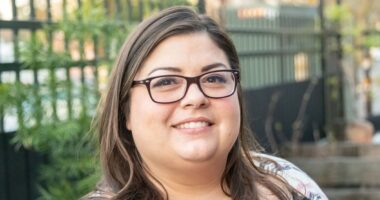The Holy Grail for the NHS is finding cost-effective ways to help patients with serious health conditions.
Chance would be a fine thing, you might think, given the many difficulties facing the Health Service.
But in fact, when I was diagnosed with the potentially deadly bone condition osteoporosis last year, after breaking my shoulder, I benefited from exactly that.
Help came in the form of the Fracture Liaison Service (FLS) at a leading London hospital.
This service, invented by a British doctor 20 years ago, is now the gold standard and has been replicated around the world.

Although osteoporosis is incurable, timely intervention through an FLS can help spare millions of women and men from the ravages of a disease which, left unchecked, can deprive sufferers of their independence, leaving them housebound and in constant agony
Although osteoporosis is incurable, timely intervention through an FLS can help spare millions of women like me – and men – from the ravages of a disease which, left unchecked, can deprive sufferers of their independence, leaving them housebound and in constant agony.
The idea behind the FLS is simple, cheap and utterly brilliant: identify hospital patients who are at risk of osteoporosis, screen them – and provide treatment if they have the disease.
An FLS identifies those at risk by checking on patients who arrive at A&E with a fracture and by combing through the records of other departments where scans for unrelated conditions might have revealed broken bones.
The service is saving countless patients each year from having their lives ruined by preventable fractures.
Not only that, according to calculations by the Royal Osteoporosis Society (ROS), FLS services more than pay for themselves in the savings on hospital and social care costs.
It says it would cost £30 million a year to set up and staff a universal service, plus £12m a year on the cost of drugs.
But over five years, it would create savings of £440m in health and social care.
I’d assumed everyone had the same access to a FLS that I did, but provision is, in fact, subject to a postcode lottery, with only half of NHS trusts in England providing the service. (Services are in every NHS trust in Scotland and Northern Ireland, while the Welsh government has pledged full roll-out, too.)
Millions of people are thereby being deprived of the care they need and are being put at risk of a pain-ridden old age.

Paul Schrijnen, 69, a business coach from Shepherd’s Bush in West London, went to A&E at St Mary’s after slipping on a wet road in March. The FLS then contacted him, which led to a scan and a diagnosis of osteoporosis. He’s now taking a weekly bisphosphonate. ‘I feel extremely lucky,’ he says
Around 90,000 people a year are missing out on osteoporosis medications because they are not being diagnosed early enough to benefit, or in some cases not at all, according to the ROS.
That is why I launched the Mail’s campaign for nationwide FLS coverage.
It’s been backed by politicians from all the major parties, and at the recent Labour Party conference, Wes Streeting, Secretary of State for Health and Social Care, said his party had ‘made the promise, and now we will keep the promise’ to start rolling out FLS across England.
Ministers have, however, so far failed to confirm the pledge as policy. Campaigners hope the Chancellor will do so in the Budget.
Osteoporosis, a bone-thinning disease that affects one in five men in the UK and half of women over 50, is the fourth main cause of disability and premature death in the UK.
‘The human cost includes extreme pain, decreased mobility and deformity,’ says Professor Alex Comninos, a consultant in endocrinology with a special interest in metabolic bone disease, at Imperial College Healthcare NHS Trust in London.’
And mortality is high, especially after a hip fracture. This is because of the risk of complications such as pulmonary embolisms [life-threatening clots in the lungs], infections and heart failure. There is also a huge cost to the NHS and to social care.
‘This is a health emergency and FLS can help address it,’ says Professor Comninos.
The FLS system identifies patients who have had a ‘fragility’ fracture – a fracture that happens through low impact or one that would not be expected to occur.
The standard treatment is a bisphosphonate, taken as a weekly pill that slows bone loss. Others may be offered regular injections or annual infusions.
As Professor Comninos explains: ‘If we catch people at the first fracture, there are simple treatments, such as bisphosphonates, that can nearly halve the risk of more fractures.
‘Other treatments – for instance, romosozumab [a monoclonal antibody drug that increases bone formation and decreases bone reabsorption] – can reduce risk by even more.’
I spent a day with the team running the FLS at St Mary’s Hospital in west London – which is one of the top performing in the country – to discover what a difference it can make.
Professor Comninos, who leads the service at St Mary’s – which has around 1,350 patients – estimates that it has prevented about 250 fractures since 2019 and saved the NHS nearly half a million pounds.
One of the patients I spoke to was Sue Yeend-Curd, 67, a retired commercial manager from Chiswick in West London who learned she had osteoporosis this year following scans for other conditions.
‘They discovered I had broken ribs, probably from a fall in August 2023, and that I had fractured vertebrae in my spine.
‘I was followed up quickly and I now take a weekly bisphosphonate tablet,’ she says.
Sue, who has two daughters with husband Paul, says: ‘I look after my granddaughter, my husband is still working and my mum is 96, so sometimes we are a bit stretched. Staying active is important to me.
‘If it were not for the FLS, the osteoporosis would never have been picked up and my bones would have been getting weaker and more vulnerable to fractures without my knowing.’
Specialist nurse Donna Rowe set up the FLS at St Mary’s in 2019 with Professor Comninos.

The idea behind the Fracture Liaison Service is simple, cheap and utterly brilliant: identify hospital patients who are at risk of osteoporosis, screen them – and provide treatment if they have the disease
She and her team trawl through A&E and fracture clinic records checking for patients over 50 who have turned up with a broken bone.
They also check with the radiology department, where X-rays are taken from up to 600 patients a week, for any with possible spinal fractures – which often go undiagnosed.
She says: ‘We’ve captured huge numbers of vertebral fractures due to osteoporosis that would never have been identified.
‘Having identified at-risk patients, the FLS offers them a DEXA scan – a type of X-ray that measures bone density.
If this indicates that they have osteoporosis – or its precursor, osteopenia, where bones are becoming weaker – they are offered medical treatment, as well as advice on diet and exercise to maintain healthy bones.
Donna Rowe says: ‘We know the diagnosis can be devastating. We focus on giving the patient information so that they can make informed choices.
‘We will investigate their fracture risk, do blood tests to see if there are any underlying conditions and look at other risk factors.’
They then pass treatment recommendations to a patient’s GP.
Paul Schrijnen, 69, a business coach from Shepherd’s Bush in West London, went to A&E at St Mary’s after slipping on a wet road in March.
The FLS then contacted him, which led to a scan and a diagnosis of osteoporosis. He’s now taking a weekly bisphosphonate. ‘I feel extremely lucky,’ he says.
Professor Comninos believes the care offered by the FLS makes it more likely that patients will stick with their treatment regimen.
People drop out for a number of reasons, such as fear of side-effects, he explains. ‘Without the FLS, by the end of one year only 10 to 30 per cent of patients who have been prescribed a weekly tablet will still be taking it,’ he says.

Around 90,000 people a year are missing out on osteoporosis medications because they are not being diagnosed early enough to benefit, or in some cases not at all, according to the ROS
‘This is where the real magic of the FLS should come in, because if patients are an active participant in their own care, they are far more likely to stick with the treatment.’
A specialist nurse checks in on patients after 12 to 16 weeks and again after a year; repeat DEXA scans are typically offered between one to five years later.
‘This way, the number of patients sticking to their treatment improves to 70 to 80 per cent,’ says Professor Comninos.
He adds that the treatments are ‘super safe’, highly effective at reducing the risk of fractures and cheap.
‘Weekly bisphosphonate pills cost the NHS as little as £7.20 a year per patient, and sometimes less.
It costs at least £10,000 if you break your hip, and some estimates put it at more than double that,’ he says.
One patient, Mary Barron, who is in her 80s, fractured her hip when she tripped while vacuuming.
She broke her wrist two years ago but was not picked up by a FLS. ‘They just fixed the first fracture and sent me home,’ Mary says.
She was identified by the FLS at St Mary’s and has had a bisphosphonate infusion that will be repeated yearly.
She says: ‘I hope now I will avoid another fracture. I live by myself, I am very independent and that is what I’d like to go back to.’
As I leave the hospital and the dedicated FLS team, I reflect on how different my situation would be if I had not been lucky enough to have access to the FLS.
‘I would have remained oblivious to the fact I would have been growing more fragile and vulnerable to disabling fractures.
‘I would have missed out on the chance to improve my odds of a happy and active life by improving my exercise regimen and diet.
Thanks to the FLS, I am on a treatment that will improve my bone strength. The FLS has given me hope after a crushing diagnosis.
If Labour rows back on its promise to give that same hope to others, it will be a senseless betrayal of millions and a needless wreckage of lives.










